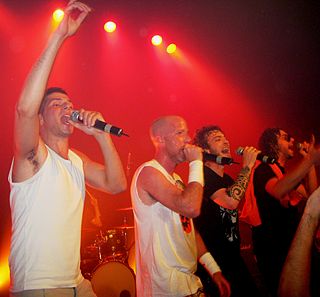
Rapping is an artistic form of vocal delivery and emotive expression that incorporates "rhyme, rhythmic speech, and [commonly] street vernacular". It is usually performed over a backing beat or musical accompaniment. The components of rap include "content", "flow", and "delivery". Rap differs from spoken-word poetry in that it is usually performed off-time to musical accompaniment. It also differs from singing, which varies in pitch and does not always include words. Because they do not rely on pitch inflection, some rap artists may play with timbre or other vocal qualities. Rap is a primary ingredient of hip hop music, and so commonly associated with the genre that it is sometimes called "rap music".
French hip hop or French rap, is the hip hop music style developed in French-speaking countries. France is the second largest hip-hop market in the world after the United States.

The Arab world, formally the Arab homeland, also known as the Arab nation, the Arabsphere, or the Arab states, comprises a large group of countries, mainly located in Western Asia and Northern Africa. While the majority of people in the Arab world are ethnically Arab, there are also significant populations of other ethnic groups such as Berbers, Kurds, Somalis and Nubians, among other groups. Arabic is used as the lingua franca throughout the Arab world.

Yemen, a country on the Arabian Peninsula, holds a prominent position in the realm of music, garnering recognition for its distinctive musical traditions. Revered as a cultural capital within the Arab world, Yemen has contributed significantly to the musical landscape of the region.

The music of Palestine is one of many regional subgenres of Arabic music. While it shares much in common with Arabic music, both structurally and instrumentally, there are musical forms and subject matter that are distinctively Palestinian.
Tamer Nafar is a Palestinian rapper, actor, screenwriter and social activist of Israeli citizenship. He is the leader and a founding member of DAM, the first Palestinian hip hop group.

Israeli hip hop refers to hip hop and rap music in Israel. Israeli hip hop artists have mainly emerged from the populations of Mizrahi Jews, Ethiopian Jews, and Israeli-Arabs, though there have also been numerous artists from Israeli Ashkenazi Jews especially Hasidim. Israeli hip hop artists enjoy wide popularity in Israel and have succeeded in appealing to international markets particularly the United States.
Tanzanian Hip-hop, which is sometimes referred to Bongo Flava by many outside of Tanzania's hip hop community, encompasses a large variety of different sounds, but it is particularly known for heavy synth riffs and an incorporation of Tanzanian pop.
Egyptian hip hop is a form of hip hop music in Egypt that draws its inspiration from local, regional and global events. Since the early 2000s, Egyptian Hip Hop has gained significant popularity and is listened to by a global audience prompted by the internet as the latest medium of technology and music streaming services such as Spotify and Anghami.

Domari is an endangered Indo-Aryan language, spoken by Dom people scattered across the Middle East and North Africa. The language is reported to be spoken as far north as Azerbaijan and as far south as central Sudan, in Turkey, Iran, Iraq, Israel, Palestine, Jordan, Egypt, Sudan, Libya, Tunisia, Algeria, Morocco, Syria and Lebanon. Based on the systematicity of sound changes, it is known with a fair degree of certainty that the names Domari and Romani derive from the Indo-Aryan word ḍom. Although they are both Central Indo-Aryan languages, Domari and Romani do not derive from the same immediate ancestor. The Arabs referred to them as Nawar as they were a nomadic people that originally immigrated to the Middle East from the Indian subcontinent.
Arabic hip-hop is a segment of hip hop music performed in the Arabic-speaking world. Due to variety of dialects and local genres which exist in the localities, Arabic hip-hop music may appear very diverse depending on the country of the song. Like most artists of the genre, the hip-hop artists from the Arabic-speaking world are highly influenced by American hip-hop.

DAM is a Palestinian hip-hop group founded in 1999 by brothers Tamer and Suhell Nafar and their friend Mahmoud Jreri from the mixed city of Lod. In 2015 female singer Maysa Daw joined the group. The group's songs are themed on protest, inequality, Israeli–Palestinian conflict, and self-criticism of Arab-Israeli society, including the violence and drug dealing within Israel's mixed cities. DAM is the best-known and most famous Palestinian hip hop group; it is also often called the "quintessential Palestinian resistance band".

The culture of Palestinians is influenced by the many diverse cultures and religions which have existed in the historical region of Palestine and the state of Palestine. The cultural and linguistic heritage of Palestinian Arabs along with Lebanese, Syrians, and Jordanians is integral part of Levantine Arab culturePalestinians also have their own dialect of Arabic called the Palestinian dialect.
Iranian hip hop, also known as Persian hip hop, refers to hip hop music in the Persian language developed in Iran and the Iranian diaspora. It originated from American hip hop culture, but has developed into a distinct rap style that draws on Iranian cultural concepts and engages with the modern issues Iranians are facing today.

Political hip hop is a subgenre of hip hop music that was developed in the 1980s as a way of turning hip hop into a form of political activism. Political hip hop generally uses the medium of hip hop music to comment on sociopolitical issues and send political messages to inspire action, create social change, or to convince the listener of a particular worldview. It was inspired partially by politically-focused 1970s artists such as The Last Poets and Gil Scott-Heron, as well as the Black Power movement, Black Panther Party and revolutionary politics of the 1960s and 1970s. Various hip hop artists emerged in the late 1980s espousing political messages and providing social and political commentary with KRS-One and his group Boogie Down Productions, and Public Enemy in particular establishing themselves as some of the first predominantly political hip hop groups with albums in 1988. Soon to follow in 1989 and following years were other political rappers, or known as "Conscious rap" including such groups as X-Clan, Poor Righteous Teachers, Paris (rapper), Disposable Heroes of Hiphoprisy and others. The genre has helped to create a new form of social expression for subordinate groups to speak about their exclusions, injustices, and lack of power.

Palestinian hip hop reportedly started in 1998 with Tamer Nafar's group DAM. These Palestinian youth forged the new Palestinian musical subgenre, which blends Arabic melodies and hip hop beats. Lyrics are often sung in Arabic, Hebrew, English, and sometimes French. Since then, the new Palestinian musical subgenre has grown to include artists in Palestine, Israel, Great Britain, the United States and Canada.

Soroush Lashkari, known professionally as Hichkas, is an Iranian rapper, singer, and songwriter. Credited with popularizing Persian hip hop to the Iranian people and other Persian-speaking countries such as Afghanistan and Tajikistan, Hichkas's national success and acclaimed works are widely regarded as having broken the barriers that were in place by the Islamic regime for the acceptance of rappers in popular music. Hichkas is considered one of the pioneers of Iranian hip hop and is nicknamed "Father of Persian Rap" by his fans. He became a representation of the Iranian underclass and reflected the angst of the young Iranians. He has been influential for many artists of various genres and is often cited as one of the greatest rappers of Iranian hip hop.

Shadia Mansour, also known as "the first lady of Arabic hip hop" is a British-Palestinian rapper who performs in Arabic and English. Much of her music revolves around Middle Eastern politics.
Lebanese Hip Hop is a pioneering movement in Arabic hip hop as Lebanese youth were among the first to be affected by hip hop culture. Arabic hip hop has received Western media attention, but most Lebanese rappers think that there is still a lack of local interest in their music. Hip hop in Lebanon is both an art form and a stage for artists to voice their alternative discourse in the public sphere.
Yemeni hip hop is a Yemeni music style and cultural movement related to rap and hip hop culture. It has influences from American hip hop and also from traditional music from the region. It is usually considered to have emerged from mid-2000s and reached its consolidation by 2009 when the first public concert was held in the French Cultural Institute. Although it has a variety of themes, there was an intense production of political songs by the Yemeni Revolution.









